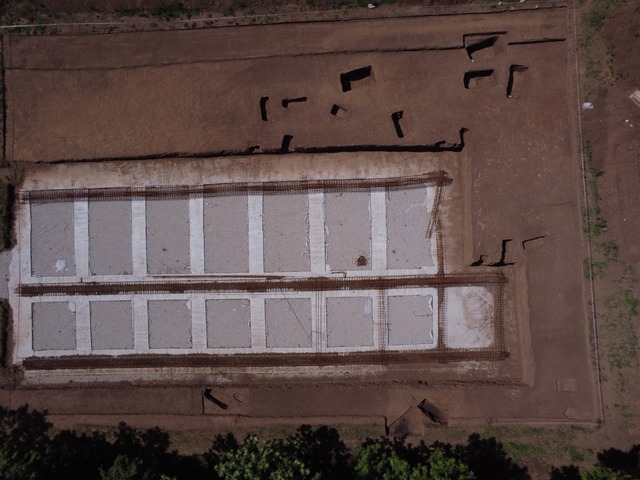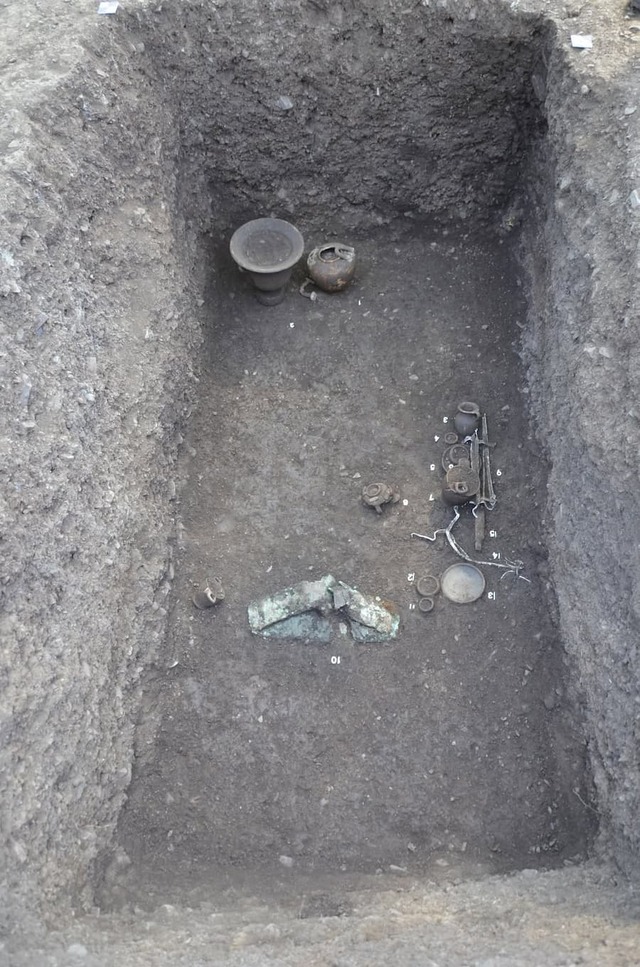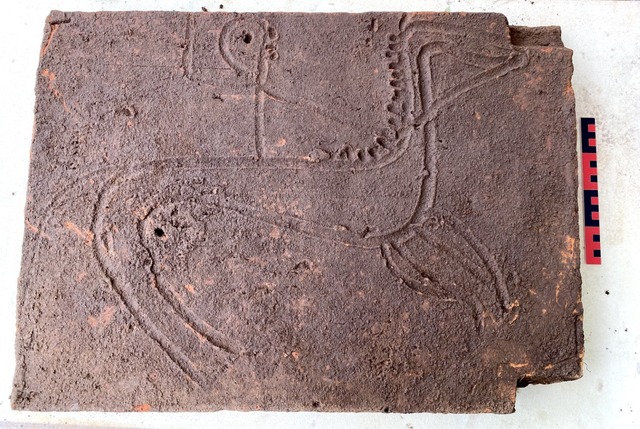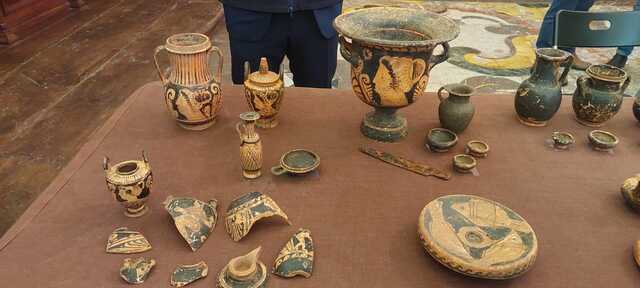In the serene hills of southern Italy, a remarkable archaeological discovery has shed light on the ancient world. Beneath the soil of Padula, an urgent excavation uncovered the tomb of a 4th-century BC warrior, offering a rare glimpse into the burial customs and martial culture of the time. Among the treasures found was a striking slab engraved with the image of a horseman, symbolizing the warrior’s esteemed status. This find not only deepens our understanding of ancient Italian burial rites but also ignites curiosity about the rich history of this long-forgotten warrior society.
The Discovery and Urgent Excavation
The discovery began under less-than-ideal circumstances. In the summer of 2024, construction work for a new stable in Padula unintentionally unearthed an array of ancient burials. The damage caused by the construction prompted swift intervention from the Soprintendenza Archeologia Belle Arti e Paesaggio di Salerno e Avellino, alongside the Lagonegro Prosecutor’s Office and the Carabinieri of the Nucleo Tutela Patrimonio Culturale. Upon arriving at the scene, archaeologists immediately recognized the importance of the site, halting construction and beginning an emergency excavation to recover and preserve the remains.


Over the course of this excavation, 19 tombs were uncovered, many of which were of the “a cappuccina” style. These tombs, characterized by walls and beds made of ceramic roof tiles, formed part of a ritual burial practice dating back to the second half of the 4th century BC. The unique combination of graves, including several simple pit graves and more elaborate tombs, suggested the area was a significant burial site—likely associated with a nearby settlement or farm. However, it was the discovery of the warrior’s tomb that truly stood out.
Video
Check out this video to explore the discovery of nineteen ancient tombs from the 4th century BC unearthed in Padula, Campania, offering a glimpse into the past.
The Tombs and Burial Styles
The burial site consisted of various tomb styles, with the most prevalent being the “a cappuccina” type. These tombs were typically rectangular in shape, constructed with terracotta tiles arranged to form a gabled roof. In these tombs, the bodies were carefully laid to rest, with grave goods arranged around them, offering insight into the deceased’s life and status. In some cases, the bodies were placed directly in the earth, with large stones marking the deceased’s head.

Among the tombs discovered, a particularly noteworthy burial was tomb number 64. This “a cappuccina” tomb contained a rich assemblage of grave goods, including several black-glazed vases and an undecorated pot. The pot, though seemingly mundane at first glance, hid an incredible artifact: a silver diobol coin minted in Tarentum between 380 and 325 BC. The coin bore the image of the goddess Athena on one side and the heroic figure of Hercules strangling the Nemean lion on the reverse—a symbol of the warrior ethos that likely defined the deceased’s life.
Unearthing the Warrior Graves
The discovery of the warrior’s tomb was particularly significant. The most striking feature of the grave was a funerary slab adorned with an engraving depicting a man on horseback. The horse, captured in mid-gallop, carries a rider wearing a helmet, raising one arm in a posture suggesting the throwing of a weapon, perhaps a spear. The artwork was rudimentary but powerful in its depiction of the warrior’s active role in combat. This image, though stylized, offered a poignant glimpse into the deceased’s identity and their high rank within their community.

In addition to the engraved slab, the tomb also contained a wealth of other items. Alongside the black-glazed vases and red-figure pottery, including a krater—a vessel associated with symposiums—archaeologists uncovered an array of personal items: an iron knife, a bronze belt worn by the deceased, metal spits, fire supports, and even a lead candelabrum. These objects not only highlight the warrior’s military status but also offer a window into the domestic and ceremonial practices of the time. The presence of household utensils in the tomb suggests that this warrior was also a significant figure within his community, playing a role in both military and social spheres.
The Engraved Slab: A Horseman Depiction

The engraved slab found in the warrior’s tomb is one of the most extraordinary aspects of this discovery. The depiction of a horseman is a rare find in ancient Mediterranean art, offering insight into the iconography used to memorialize high-status individuals. The engraved figure of the rider on horseback, in full gallop, evokes imagery of strength, nobility, and martial prowess—qualities that were highly revered in ancient societies.
The fact that the engraving was created before the slab was fired suggests it was an intentional part of the tomb’s construction, serving as a symbolic tribute to the deceased’s identity. In ancient cultures, such depictions often had deep ritual significance, reinforcing the individual’s connection to the gods and their heroic deeds. The horseman, who may represent the deceased or a divine protector, adds a layer of mysticism and reverence to the warrior’s final resting place.

Other Notable Finds: Household Items and Ceremonial Objects
Beyond the warrior’s tomb, other graves revealed fascinating insights into ancient social life. The discovery of black-glazed ceramics, including several vases adorned with red-figure images of women, suggested that ritual practices played an important role in the funerary customs of the time. Among these ceremonial items were also found practical objects like iron knives, metal spits, and a lead candelabrum—each serving as both personal belongings and symbolic objects to accompany the deceased in the afterlife.
In some cases, the vases found in the graves were linked to post-burial rituals, as they were positioned outside the tombs. This suggests that the people of this region practiced a complex and evolving set of rites, possibly involving offerings to honor the deceased and ensure their continued influence in the afterlife.

The Role of the Warrior in Ancient Society
The items discovered in the tombs underscore the pivotal role that warriors played in ancient Mediterranean society. The belt found in the warrior’s tomb, for example, is a clear symbol of military prowess, while the presence of household items highlights the individual’s importance not only in warfare but also in maintaining the cultural and social fabric of the community. Warriors, like the one buried in tomb number 64, were often viewed as protectors and leaders, their lives intricately intertwined with both the spiritual and material aspects of ancient society.
These findings also speak to the broader function of warrior burials during this period. The engraved images, the presence of weapons, and the choice of grave goods all suggest that these individuals were honored not only for their military service but also for their contributions to their families and communities. The warrior’s tomb becomes a testament to the blending of martial and domestic roles in ancient societies.
Video
Watch this 4K video to explore the stunning Roman ruins at Baalbek, Lebanon, showcasing their impressive architecture and historical significance.
Conclusion: Preserving Ancient Southern Italian Culture
The discovery of the 4th-century BC warrior’s tomb in Padula offers a fascinating glimpse into the past, revealing the complex cultural, religious, and social dynamics of ancient Southern Italy. From the engraved horseman slab to the array of burial goods, these findings provide invaluable insights into the lives of high-status individuals during this period.
As we continue to unearth the past, the protection and preservation of such sites becomes more crucial. This discovery not only deepens our understanding of ancient Italian burial customs but also serves as a reminder of the rich cultural heritage that remains hidden beneath the soil. With the intervention of authorities and archaeologists, the tombs of Padula will continue to shed light on the warrior cultures of the Mediterranean, offering a window into the lives of those who shaped ancient history.



